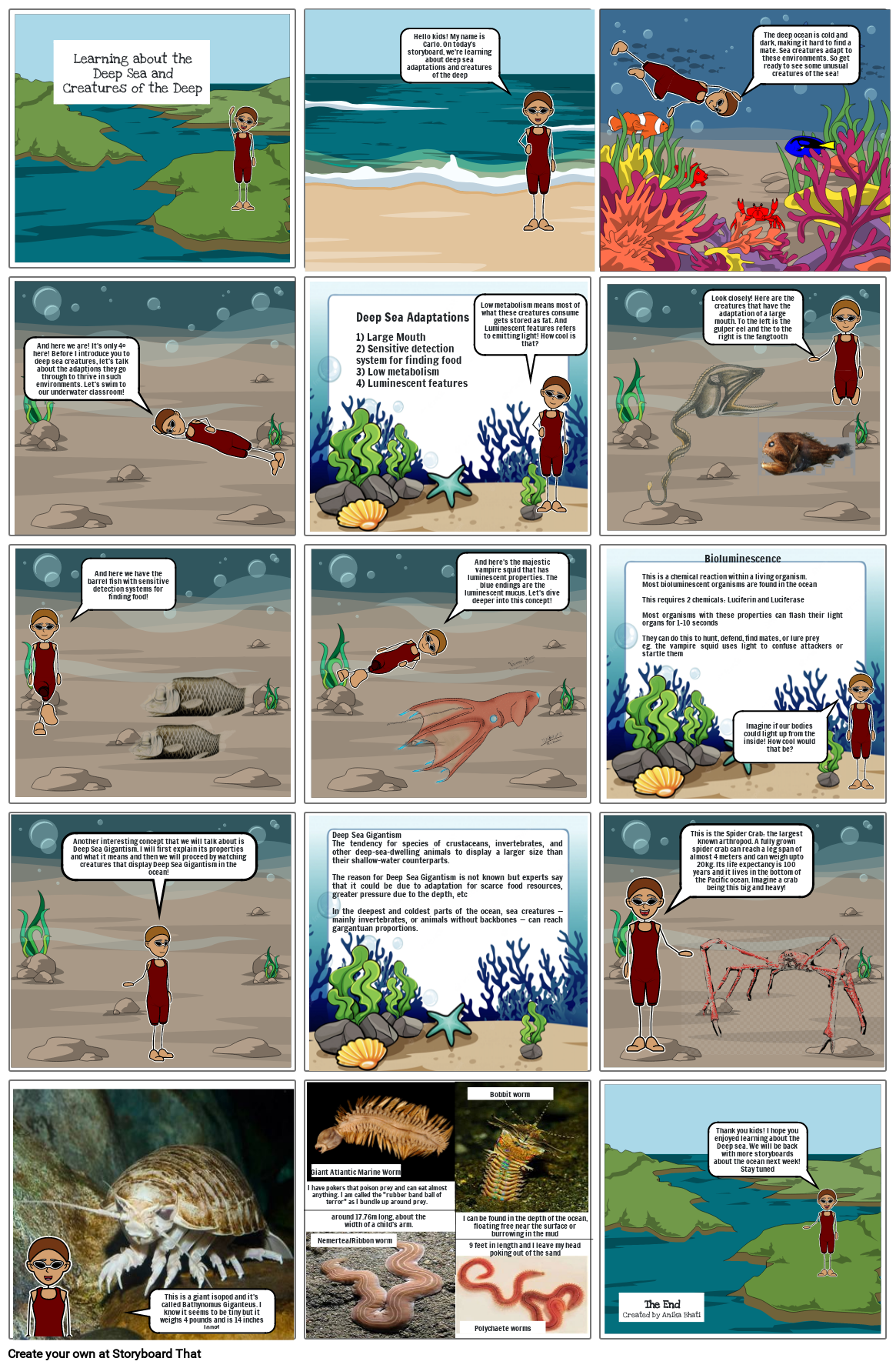ee144

Storyboard Text
- Learning about the Deep Sea and Creatures of the Deep
- Hello kids! My name is Carlo. On today's storyboard, we're learning about deep sea adaptations and creatures of the deep
- The deep ocean is cold and dark, making it hard to find a mate. Sea creatures adapt to these environments. So get ready to see some unusual creatures of the sea!
- And here we are! It's only 4° here! Before I introduce you to deep sea creatures, let's talk about the adaptions they go through to thrive in such environments. Let's swim to our underwater classroom!
- Deep Sea Adaptations1) Large Mouth2) Sensitive detection system for finding food3) Low metabolism4) Luminescent features
- Low metabolism means most of what these creatures consume gets stored as fat. And Luminescent features refers to emitting light! How cool is that?
- Look closely! Here are the creatures that have the adaptation of a large mouth. To the left is the gulper eel and the to the right is the fangtooth
- And here we have the barrel fish with sensitive detection systems for finding food!
- And here's the majestic vampire squid that has luminescent properties. The blue endings are the luminescent mucus. Let's dive deeper into this concept!
- BioluminescenceThis is a chemical reaction within a living organism.Most bioluminescent organisms are found in the oceanThis requires 2 chemicals: Luciferin and LuciferaseMost organisms with these properties can flash their light organs for 1-10 secondsThey can do this to hunt, defend, find mates, or lure preyeg. the vampire squid uses light to confuse attackers or startle them
- Imagine if our bodies could light up from the inside! How cool would that be?
- Another interesting concept that we will talk about is Deep Sea Gigantism. I will first explain its properties and what it means and then we will proceed by watching creatures that display Deep Sea Gigantism in the ocean!
- Deep Sea GigantismThe tendency for species of crustaceans, invertebrates, and other deep-sea-dwelling animals to display a larger size than their shallow-water counterparts.The reason for Deep Sea Gigantism is not known but experts say that it could be due to adaptation for scarce food resources, greater pressure due to the depth, etc In the deepest and coldest parts of the ocean, sea creatures — mainly invertebrates, or animals without backbones — can reach gargantuan proportions.
- This is the Spider Crab: the largest known arthropod. A fully grown spider crab can reach a leg span of almost 4 meters and can weigh upto 20kg. Its life expectancy is 100 years and it lives in the bottom of the Pacific ocean. Imagine a crab being this big and heavy!
- This is a giant isopod and it's called Bathynomus Giganteus. I know it seems to be tiny but it weighs 4 pounds and is 14 inches long!
- Giant Atlantic Marine Worm
- I have pokers that poison prey and can eat almost anything. I am called the "rubber band ball of terror" as I bundle up around prey.
- Nemertea/Ribbon worm
- around 17.76m long, about the width of a child's arm.
- 9 feet in length and I leave my head poking out of the sand
- I can be found in the depth of the ocean, floating free near the surface or burrowing in the mud
- Polychaete worms
- Bobbit worm
- The EndCreated by Anika Bhati
- Thank you kids! I hope you enjoyed learning about the Deep sea. We will be back with more storyboards about the ocean next week! Stay tuned
Over 30 Million Storyboards Created
No Downloads, No Credit Card, and No Login Needed to Try!


